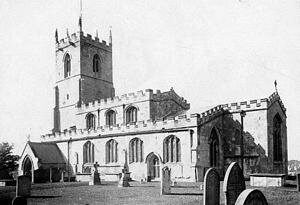The Ducal Vault at Harthill
The following extract from the Leeds Mercury 1900
 Having purchased the Harthill estate while still Earl of Danby, this nobleman had the arrangement of the fine mortuary chapel in the north-east corner of Harthill Church. The almost concealed window contains shields exhibiting the marriages of his large family, executed in painted glass by W. Price in 1705. The huge tomb of the first Duke, with its highly polished black marble top, blocks up the entrance to this chapel. Over it, in semi darkness, hangs a dusky display of armour, a very beautiful shield is embossed metal, some faded banners, and a Civil War standard. One curious white flag bearing a snowdrop has the following legend, which I had from the sexton. Lord Conyers, heir-presumptive to the Dukedom, was a youth of 19 at college, and one night, when on his way to bed, he had a sparring match with one of his best friends at the stairs-end of a corridor. By some accident he fell back-wardsway down the stairs, and injured his spine, from which he never recovered. Some nuns worked the banner for the Duchess, his sorrowing mother, "and put a snowdrop on it." So says old William Drabble.
Having purchased the Harthill estate while still Earl of Danby, this nobleman had the arrangement of the fine mortuary chapel in the north-east corner of Harthill Church. The almost concealed window contains shields exhibiting the marriages of his large family, executed in painted glass by W. Price in 1705. The huge tomb of the first Duke, with its highly polished black marble top, blocks up the entrance to this chapel. Over it, in semi darkness, hangs a dusky display of armour, a very beautiful shield is embossed metal, some faded banners, and a Civil War standard. One curious white flag bearing a snowdrop has the following legend, which I had from the sexton. Lord Conyers, heir-presumptive to the Dukedom, was a youth of 19 at college, and one night, when on his way to bed, he had a sparring match with one of his best friends at the stairs-end of a corridor. By some accident he fell back-wardsway down the stairs, and injured his spine, from which he never recovered. Some nuns worked the banner for the Duchess, his sorrowing mother, "and put a snowdrop on it." So says old William Drabble.
Eleven steps lead down through an iron flap-door to the Ducal vault beneath the mortuary chapel. Here sleep the first Duke's descendants - seven successive Dukes, several Duchesses, and other members of the family. Twenty four coffins, most of them retaining their red plush covering, brass-head nails, and sheet-brass coronets, are laid on the stone-wall bench and an iron table. The last internment was that of the 7th Duchess.
There is some talk of walling the vault up permanently. It is almost gratifying to find muteness taking the place of inscriptional eulogies, for eulogy is always dangerous until a man is dead, and then it is superfluous. The place is sad, as all vaults and mausoleums are; scarcely so gruesome, though, as the crypt in Hythe Church - that Golgotha of Danish skulls which made such an impression on George Borrow's Lavengro when a boy. One congratulates one's self on being a common Mr. Blank, who can die and be buried in the green sod, and be forgotten by even the genealogist. "O, the blessing of cremation!" I cried with the Duke of Argyll as the vault-cover clapped down and filled up the hole of unburied death!
The second Duke of Leeds was Peregrine Osborne. Early in 1692 he got appointed to the 90-gun ship Windsor Castle, in which, as Rear-Admiral, he took part in the battle of Barfleur. In 1695 he was Rear-Admiral of the Blue Squadron under Berkeley; "but in the summer," says the historian Burnet, "while Berkeley was bombarding St. Malo or Dunkirk, Osborne was detached to cruise in the soundings for the protection for the homeward trade. By a grave error in judgement he mistook a merchant ship in the distance for the Brest fleet, and, conceiving that his force was insufficient, drew back to Milford in time to allow the West Indies trade to fall into the hands of the French."
Before quitting this subject I feel bound to mention the present Duke of Leeds. He came into prominence when Marquis of Carmarthen as Conservative candidate for Brixton in 1885. After representing this division in Parliament for 10 years, he succeeded to the Dukedom. He is the popular Master of the Bedale Hunt, and was for a short time Treasurer of the Queen's Household. The Duke and Duchess have four daughters, but no son and heir, so at present the heir is the Duke's brother, Lord Francis Osborne, who married Ruth, the daughter of Admiral Grieve, and a relative of Lord Elibank. The Duchess of Leeds, known for her magnificent eyes, is one of the most accomplished Ducal dames of to-day. Her Grace is an exceedingly intellectual and clever woman, and devotes much of her time to literature and music. As an authoress, she has no mean reputation, her "Capriccios," a volume of short stories, published by Hodder and Stoughton in November, 1898, being very highly thought of. She is also the author of the novel, "A Lover of the Beautiful." Her Grace devotes all the proceeds of her literary work to charitable objects.
Read about Harthill
Read about Dukes of Leeds
